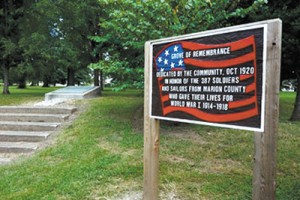How do we remember heroes? Are they memorialized as armed sentinels of bronze and stone standing vigilant on court house squares and in village parks where once or twice a year a wreath is placed amid words of thanks and praise? Are names emblazoned on plaques of those who served and died? Lest we forget, “In Flanders fields the poppies blow, between the crosses, row on row.” How to honor Hoosiers who served in the Great War — World War I, those who served and died, yes, but also those who served and survived. Remembrance and memorialization were subjects of debate in the months following Armistice Day — November 11, 1918.
Days before the guns were silenced, the American Forestry Association urged the state governors to plant memorial trees along the nation’s public roads for the honored dead. While in general agreement with the idea, Indiana Gov. Goodrich “thought that groves of trees would be found more expressive of the valorous deeds of our boys over there and as an outdoor memorial would be found more suggestive of those who had made the supreme sacrifice than any monument of stone or bronze could be.” Richard Lieber, chair of the Indiana State Park Commission and secretary of the state forestry board, was given the task to begin a county tree planting campaign to honor the Hoosier fallen.
Across Indiana, memorial groves were planted. In Richmond’s Glen Miller Park a red oak was planted for each Wayne County service member who died and in Ft. Wayne’s Memorial Park a grove of white oak, hackberry, elm and tulip trees was planted representing the Allen County men and women who died in active service. In the center of Riverside Park at Logansport six trees were planted “in memory of local boys who gave their lives in the cause of the great war.”
Indianapolis Arsenal Technical High School chose to honor all of the students who were sent to the front — 232 boys and one girl — with native trees placed in the southeastern part of the school’s campus. Liberty Grove was dedicated in ceremonies held on Armistice Day (Veterans Day), November 11, 1919. With additional names made known, more trees were added to the grove and to honor those “who paid the supreme sacrifice” and four trees were specially decorated.
The Grove of Remembrance, on a knoll in the northwest part of Garfield Park, was planted with 290 trees to honor the dead from Marion County. During solemn ceremonies, under the auspices of the Hamilton-Berry Chapter of the Service Star Legion, the Grove was dedicated on Sunday, October 31, 1920 and presented to the Gold Star families. Each of the 290 trees was marked with the “name of the person which it is to represent.” Placed under the care of the park commissioners, additional trees were added to the grove as county records were supplemented with information of those who died in the service of their country, bringing the total to 387 trees. After years of neglect and public works incursions through the memorial woods, efforts were taken to re-establish the grove and re-dedication ceremonies were held at the Grove of Remembrance on July 29, 1995.
While planting memorial trees was a popular way for communities to show respect and remember the sacrifices of those who served, there were proposals for putting up memorial buildings. Residents of the Indianapolis suburb of Irvington developed plans for a community house as a memorial to Irvington soldiers and sailors. Working in cooperation with the city parks department, the Irvington Memorial Association launched a campaign to raise matching funds to have the community house built in Ellenberger Park. Sadly, this effort fell short and was abandoned after a few years.
A substantial memorial building and plaza to honor all of those from Indiana who answered the call to service is the World War Memorial building and plaza in downtown Indianapolis. The idea of a great state plaza in the center of the city with public memorials to notable Hoosiers had been discussed for years. With the Armistice in Europe and the imminent return of Indiana men and women from France, plans began in earnest to establish a plaza to honor their service. In addition, the decision by the American Legion to locate its headquarters in the Hoosier capital provided further impetus to the project.
The land from St. Clair to Michigan Streets, between Meridian and Pennsylvania Streets, was transformed into a plaza containing a black granite cenotaph to commemorate those who died in service, at the north end and offices of the American Legion flanking the square; a black granite obelisk and fountain placed in the center of the plaza; and the monumental memorial shrine building located on a square south of the plaza.
The limestone clad Indiana World War Memorial Building is the focus of the state’s tribute to those who served in the Great War. Inside, along the two marble staircases leading from the Grand Foyer to the Shrine Room are inscribed panels containing the names of all Hoosiers serving in the war. Here and there, beside a name, a gold star denotes a fallen hero.
Memories and memorials are all that was left when the last veteran of World War I passed on. The “War to End All Wars” sadly was not. Hoosiers answered the call for World War II, the Korean War, the Vietnam War, the First Gulf War, the Second Gulf War, and the War in Afghanistan, and the War on Terror. Stories will be told, and memorials will be built, and on November 11th year in and year out we will remember those who served and died, and those who served and survived. Don’t forget to wear a poppy.



